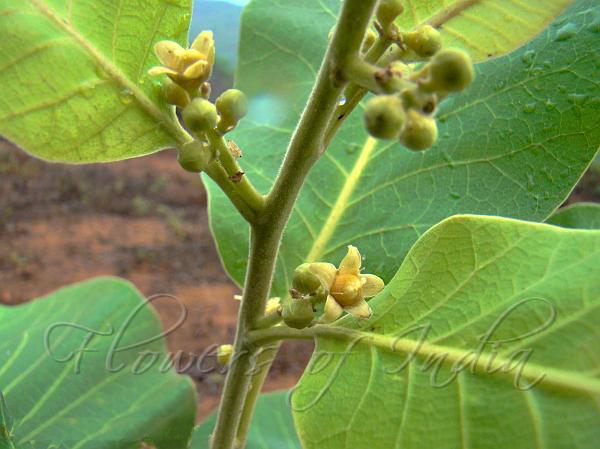|
| Marking Nut |
|

|

| File size | 1212738 |
| Original date | 5/20/09 5:42 PM |
| Resolution | 2048 x 1536 |
| Flash | Flash did not fire, auto |
| Focal length | 5.2mm |
| Exposure time | 1/125s |
| Aperture | 4.0 |
| Focus Distance | |
| Metering Mode | Multi-segment |
| Camera make | SONY |
| Camera model | DSC-H50 |
| Sensor type |
|
|
|
|
Photo: |
Botanical name: Semecarpus anacardium Family: Anacardiaceae (Cashew family)
Synonyms: Anacardium orientale
Synonyms: Anacardium orientale
Marking Nut is a moderate-sized deciduous tree with large stiff leaves.
Leaves are 7-24 inches long, 2-12 inches wide, obovate-oblong, rounded a
t
the tip. Leaf base is rounded, heart-shaped or narrowed into the stalk,
leathery
in texture. Flowers is small, borne in panicles shorter than the
leaves. Fruit is a drupe 1 inch long, ovoid or oblong, smooth
and shining,
black when ripe, seated on a fleshy cup. The stem yields, by tapping, an
acrid, viscid juice from which a
varnish is prepared. The nut yields a
powerful and bitter substance used everywhere in India as a substitute for
marking ink for clothes by washermen, hence it is
frequently called Dhobi
Nut. It gives a black colour to cotton fabrics,
but before application it
must be mixed with limewater as a fixator. The
fruits are also used as a
dye. They are also largely employed in Indian
medicine. The fleshy cups on
which the nuts rest and the kernels of the
nuts are eaten.
Medicinal uses: The fruit is useful in leucoderma, scaly skin,
allergic, dermatitis, poisonous bites, leprosy, cough, asthma, and
dyspepsia. It is extremely beneficial in the diseases like piles, colitis,
diarrhea, dyspepsia, ascites, tumours and worms. The topical application
of its oil on swollen joints and traumatic wounds effectively controls the
pain.
The fruit is useful in leucoderma, scaly skin,
allergic, dermatitis, poisonous bites, leprosy, cough, asthma, and
dyspepsia. It is extremely beneficial in the diseases like piles, colitis,
diarrhea, dyspepsia, ascites, tumours and worms. The topical application
of its oil on swollen joints and traumatic wounds effectively controls the
pain.
Medicinal uses:
 The fruit is useful in leucoderma, scaly skin,
allergic, dermatitis, poisonous bites, leprosy, cough, asthma, and
dyspepsia. It is extremely beneficial in the diseases like piles, colitis,
diarrhea, dyspepsia, ascites, tumours and worms. The topical application
of its oil on swollen joints and traumatic wounds effectively controls the
pain.
The fruit is useful in leucoderma, scaly skin,
allergic, dermatitis, poisonous bites, leprosy, cough, asthma, and
dyspepsia. It is extremely beneficial in the diseases like piles, colitis,
diarrhea, dyspepsia, ascites, tumours and worms. The topical application
of its oil on swollen joints and traumatic wounds effectively controls the
pain. | Identification credit: Pravin Kawale | Photographed in Maharashtra & Jharkhand. |
• Is this flower misidentified? If yes,